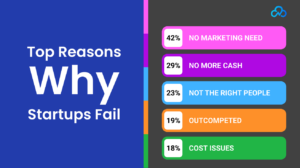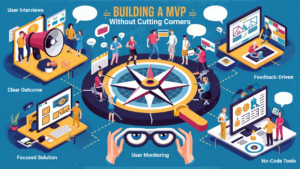Introduction
Starting up a new business venture in the year 2025 requires massive determination. The number of competitors has surged while technology advancement speeds up and users’ demands escalate forcing new firm founders to accomplish quick results before earning their first round of praise. Your journey toward success will massively benefit from deciding between creating a Minimum Viable Product (MVP) or constructing a complete product solution.
The article provides straightforward useful guidance about this particular question. The success of your startup hinges on your ability to decide between creating the basic MVP format or launching the complete product because both options deliver different benefits to startups.
The Appeal of a Full Product (And Why Startups Often Get It Wrong)

A significant 42% of startups fail because they develop products or services that don’t align with market demands.
Developing an entire product seems attractive to many developers. It feels safer. It gives you more control. You can build every possible feature from your imagination before designing to achieve a product that users will really enjoy.
The main challenge with developing entire products is their requirement of extensive time and financial resources as well as numerous guesses about user needs. Building features without obtaining genuine user feedback might lead your project to take months before creating solutions that users find unimportant. New startups who search for product-market fit face excessive risk when they commit resources to building complete products.
Too early full product development usually results in what’s called “feature bloat” where organizations incorporate multiple tools and functions without assuring user demand for them. Such development results in products with higher difficulty of use which also costs more to maintain and upgrade. Each week you devote to construction work without user learning means you miss out on critical user need adaptation. The ability of startups to be agile depends on not being stuck with an overloaded product because this prevents quick and affordable pivots.
The full development of a product needs extended timelines which require a bigger team to complete work. Your financial resources get depleted at an accelerated rate resulting in a shorter time frame for profit generation which introduces additional urgency to produce financial returns quickly. The amount of failure expense will be significantly higher as a result of incorrect assumptions. Future business success begins with MVP Software development because it enables testing and learning toward eventual growth and expansion.
Why MVPs Make Sense for Startups
Startups live in uncertain environments. The validation process extends beyond the basic concept to cover market spaces and business framework and company position. MVP Software allows you to:
1. Check your main hypothesis immediately to determine whether users actually face this issue. Will they pay to solve it? An MVP functions to confirm your main market hypothesis by allowing quick tests without requiring wild guesses. Through using an MVP you get the opportunity to determine if users appreciate the solution you propose without risking deep financial commitments beforehand.
2. Development expenses decrease because building software becomes less time-consuming and no extensive hiring is required. MVP Software enables businesses to create their products while safeguarding their finances through the use of lean technologies, no-code platforms and small teams. The lean approach saves your cash resources while allowing advancement to occur without running out of time.
3. Users provide genuine feedback that indicates working features and nonworking elements. Early user involvement with your product enables you to obtain essential feedback for improving the following version. When you build your product you will share a collaborative development process with your customers through co-creation.
4. Early adopters and investors will find enough value in your executed MVP to secure their interest and financial support. Your Product MVP‘s ability to attract real users creates both market credibility and liberal funding prospects regardless of your financial approach
Startup MVP Development: A Strategic Approach
Good Startup MVP Development begins with obtaining clear product specifications. Your product addresses only one key challenge for customers. What is the basic version of your product that provides the necessary solution?
When developing an MVP to monitor remote team productivity your basic product version should incorporate a simple dashboard that tracks time usage while allowing team members to join remotely. Keep the features of custom reports and gamification alongside integrations on hold for the present.
Prioritize learning over scaling. The main purpose of initial launch is providing valuable functionality while you prove your initial assumptions which will guide the development path ahead.
Your basic initial version exists as proof of concept rather than demonstrating advanced functionalities because your main goal is to validate your product idea. Your efforts will remain focused on vital features and you will prevent scope growth, maintain a streamlined development process and continue following your product vision. By delivering a minimum viable product you will get the ability to shift directions according to user feedback instead of previous assumptions.
When a Full Product Might Make Sense First
Which conditions would make launching a complete product a superior solution? The situation occurs infrequently when startups have these conditions:
If you are releasing a second product to existing users you have well-tested market information. Since you already understand customer needs and preferences along with marketplace demand, the risk of developing an inappropriate solution becomes much lower.
Fintech and healthcare businesses demand strict product compliance that makes launching an incomplete solution illegal. The strict data regulations present in these businesses require complete solutions before any public launch becomes possible.
Large financial resources combined with experienced personnel and established success in creating products provide suitable conditions for a big launch. Seasoned founders sometimes use full builds as market-entry strategies but they need significant funding as their mistakes can result in substantial losses.
Startup founders at large represent a statistical minority in this situation. The incomplete resources plus little funding and uncertain product concepts define your operating situation. That’s where MVP Software shines. Your venture enables you to verify the concept while collecting genuine user comments while sparing your budget. Poorly predicted environments prove more successful when a company makes small bets.
Examples of Great Product MVPs
In fact, so many of these big name products began with very simple MVPs.
– The founders of Airbnb tested demand by renting out air mattresses, and were booking manually.
– In Dropbox the first step was to release an explainer video before writing any software to see if people would be interested in their idea.
Instead, these companies saved time but built user-centered products, informed by actual experience.
The Risks of Skipping the MVP Stage
When companies start making a product without building an MVP first they face financial damage plus several other losses:
– You will use months developing product features that fail to find a market.
– You cannot tell if your product meets an actual need when users do not try it out in reality
– Team members and project opportunities face frustration as they complete product development over a long time while waiting for feedback.
– Your project gets more difficult to adapt as you build larger amounts of features first
How to Build Your MVP Without Cutting Corners
Selecting MVP Software does not lead to construction of inferior low-quality products. You create a practical solution when you select an MVP Software strategy.
Here are a few guidelines:
1. Conduct interviews with target customers first before starting any product creation. Understanding customer problems will lead you to make positive design choices and ensure you do not waste development time.
2. Decide what your product needs to achieve in order to help customers. Your focus should be on perfecting one main problem instead of attempting to handle all tasks at once.
3. Build only for one specific user experiencing one distinct issue through a single solution. Simplicity lets you build an entire plan around the key message while developing in a focused manner.
4. Turn to no-code development tools as they provide quick testing platforms to validate your ideas at minimal development expense.
5. Install monitoring tools at once to see how users use the product and where they give up. This critical information guides better future plans.
6. Rephrase your designs based on what users tell you instead of guessing. Ask, listen, and adapt.
When designing your minimum viable product you should base it on real-world challenges. Make an efficient solution that fixes a true user challenge. At first glance your Minimum Viable Product (MVP) must earn trust because this first interaction affects users and potential investors.
Budgeting for Startup MVP Development
MVP Software costs can vary. The cost of developing an MVP depends on how many features the project includes and the size of your team along with your toolkit choices.
– No-code MVPs: Ideal for internal tools, marketplaces, or lightweight SaaS products. Fast and cheap.
– Custom-built MVPs: Better for unique functionality or long-term scalability.
Put in only the necessary funds needed to test your main concept. To proceed with further development you need to show audience interest first which lets you decide whether you can get investors or need more time.
What Comes After MVP?
After your basic product performs well you will use existing data to determine next development actions.
Key questions to consider include:
– Where are people dropping off?
– Are users willing to pay?
– You will progress from creating your MVP to creating the Product MVP that grows further based on user preferences.
At this point you have achieved the ideal position for your product in the market. At this point you will begin expanding the product into its official release format.
FAQS
1. What is MVP Software and why is it important for startups?
The term MVP Software means launching a basic product version to test market acceptance. Startups need this technique for fast feedback and cost savings on development while learning from user perspectives.
2. What is the difference between a Product MVP and a full product?
A MVP product offers basic solutions to one clear issue yet a full version adds all functions with room for growth. The MVP serves as a quick market check whereas a complete product system helps companies grow their business once their idea proves successful.
3. When should startups invest in full product development instead of an MVP?
Build up your entire product if you have confirmed market demand and you must follow industry regulations through a tested minimal viable product (MVP Software). Most startups find Startup MVP Development to be a better way to reach success with lower danger.
4. How much does it cost to build MVP Software for a startup?
MVP Software development expenses range between $5,000 when using no-code tools and $50,000 and up for customized built versions. The total cost of building an MVP depends on several factors that include how complicated it is and what technology you need plus whether you will use your own staff or pay a professional company.
Final Thoughts
For startup founders the right decision usually is to create an MVP before making a complete product. Build MVP Software. Validate fast. Learn faster.
An MVP serves as a well-planned tool to decrease project danger and create results through effective spending. Building a basic prototype is the best way to achieve meaningful impact with minimal resources. To succeed you must develop a specific solution to address customer needs and plan your product development steps ahead.
So start smart. Test boldly. In startup culture speed to market and understanding customers surpasses production of flawless products.
Do you like to read more educational content? Read our blogs at Cloudastra Technologies or contact us for business enquiry at Cloudastra Contact Us.
